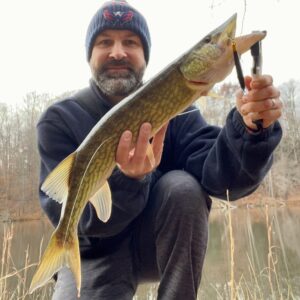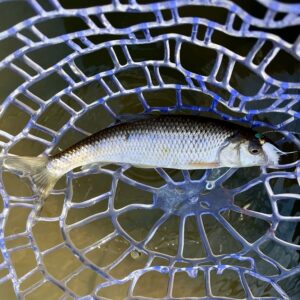Welcome to Reel Chesapeake’s Weekly Fishing Report, our interpretation of what’s biting and where throughout the Chesapeake Bay watershed. Please email us directly at editor@reelchesapeake.com to share updates and photographs of your recent catches for potential inclusion in next week’s column. The leading photograph (above): Sight fishing for northern snakehead remains hot in many Chesapeake tributaries. This 26” specimen was caught at noon in the upper Patuxent on Wednesday, hitting a topwater frog. Photo by yours truly.
It’s refreshing and amazing how a regionwide cool down from 90F-plus degree days to high-70s gets folks chirping about the coming fall season. Though we’re still in the dog days of August (just starting really), it certainly hasn’t felt like them. The middle Chesapeake experienced several fronts blow through late last week (a few with high winds and rain). This caused temps to drop, both air and water, and flows to increase in many watersheds. Then a consistently calm start to this week piggybacked those fronts and has made for very pleasant outings. Oh, and striped bass season reopened on August 1st throughout Maryland’s portion of the bay. Everything seems right and good.
Northern snakehead fishing continues to be excellent right now. Sight fishing for them in all their haunts is producing many fish, and big ones! On Sunday, I fished a Little Patuxent River hole and met a couple others doing the same. Their take is that the snakehead have started moving downriver. We didn’t see any at this spot, but did hook into largemouth bass. A few days later, on Wednesday, I visited another Patuxent stretch—indeed, downriver from the last—and spotted a nice specimen swimming south toward me on the far bank. I had just enough time to reach for my frogging rod and launched/landed the topwater lure about five yards ahead of the fish. It started following the plops and then attacked the bait…hooked ’em! What a pleasant and fortuitous encounter with a solid 26” specimen. Had I hit a stop light en route to this spot, I would have missed this fish lazily swimming by. But I digress.
Search for snakehead in slow-moving and standstill water, especially thick with cover, at any accessible honey hole along the Patuxent from Bowie south. Jug Bay could be especially juicy right now. Many snakehead are protecting fry—possibly from a second spawn even—and can be enticed with topwater creature baits, buzzbaits, chatters, and inline spinners. The creeks of the Potomac, the upper Bay rivers, and Blackwater on the east side—any rivershed with grass and/or pad abundance—will be holding snakehead.
Bluefish and Spanish mackerel continue to be the talk of the middle bay, as anglers eagerly await their arrival. Bluefish have been caught from the Bay Bridge south and, just this week, we’ve heard the first reports of mack encounters in the Poplar Island vicinity (one angler claimed eight hookups!). They should push across to Thomas and Tolley Points within a couple days and maybe even reach as far north as Hacketts Bar and the bridge (even further?). Try trolling #1 or #2 planers with mid-sized Drone, Clark, or Tony spoons at about 5–7mph to get strikes. If you find a feeding school, try casting G-Eye rain minnows, 1/2oz Kastmasters, or other metals ahead of the frenzy and retrieve through it as fast as you can reel.
Tuesday marked the opening of “fall” striper season, which continues through December 10th, during which recreational anglers may keep one 19–31 slot fish per person per day (two if fishing on a charter vessel). Those who’ve jumped at them are having success at sunrise and sunset with topwater plugs like Smack-It Juniors, big spooks, or MirrOlure Popa Dogs, or flycasting large Deceivers and similar streamers. The Key Bridge in the Patapsco, shorelines of Eastern Bay, and Poplar Island’s riprap further south are the primary targets of the charter fleets. If you want consistent schoolie action in the 17–21” class, head into the mid-bay rivers (Magothy, Severn, South, West/Rhode, Chester, Choptank) and try similar tactics at similar hours at any sandbar, stretch of riprap, or grass flat. The amount of baitfish in the rivers and their creeks continues to be shockingly abundant. And stripers are feeding well at low light. The feeding windows will continue to widen as fall approaches.
For midday fishing, hit the deepest-water docks you can find, shaded shorelines with deep drops, and deep channel structure. Deep is the name of the game, where stripers will hold but can be enticed with classic jigging techniques (I love 3/8–1/2oz bucktails or jig/paddletail combos). Live liners are also active throughout the Bay, catching spot to fill the livewell before dropping the baitfish into the middle of marked schools or around bridge pilings—the Bay Bridge and drops on either side of the shipping channel are where many anglers begin their day trying this technique.
White perch have been tough to find for those searching throughout the main Bay, and here’s why. The fish are still loaded in the rivers and creeks—they’re still stacked upriver, so to speak, with all the baitfish. It’s that simple. We continue to slam the perch in the Round Bay vicinity of the Severn River, for example. Again, aim for structure and shade with small offerings. Quarter-ounce spinnerbaits, 1/4oz Kastmasters, 1/8oz jig/micropaddles, and 1/16oz stingers will produce hits. Of course, grass shrimp or pieces of bloodworm lowered down on a small #6 hook is surefire.
Another interesting development has been an increase in puppy drum (only up to 17” or so) being caught within these same mid-bay rivers, and as far north as the Magothy. Several anglers have boasted these rather rare catches on social media this week. The big bulls are still south, however, and will continue to feed in the shallows of Tangier onward to the bay’s mouth and the Atlantic beyond. Cutlass fish have also been consistently in the mix, especially in the Point Lookout vicinity. The cobia run into the bay hasn’t seemed to push as far north as hoped, with most reports still coming from the Virginia line south.
And crabbing…what can we say? It’s hit or miss and dependent on beating others to the potential hotspots in the wee hours of the morning just in time for sunrise. Bushel catches are possible for trot liners in most of the rivers. Folks report depths under 10 feet—with most reporting 5–7’—are where the crabs are sitting. We tried chicken necking off a pier last weekend and caught less than a dozen. Just got to keep trying. Good luck!
This report appears within On The Water magazine’s weekly collection of Chesapeake Bay fishing reports.






